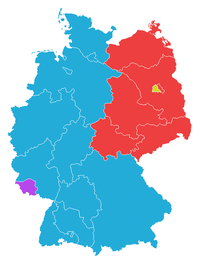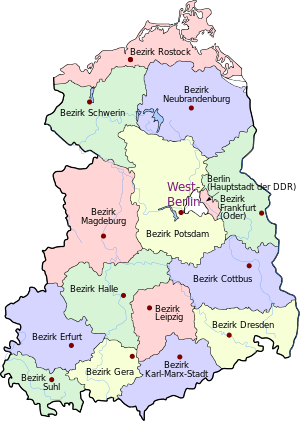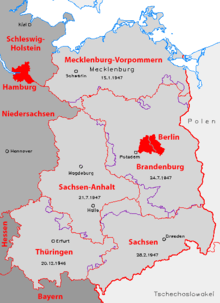Administrative divisions of East Germany
The administrative divisions of the German Democratic Republic (commonly known as East Germany) were constituted in two different forms during the country's 41-year-long history. The GDR first retained the traditional German division into federated states called Länder, but in 1952 replaced them with arbitrarily-drawn districts called Bezirke. Immediately before German reunification in 1990, the old Länder were restored, but they were not effectively reconstituted until after the GDR had ceased to exist as a separate state.
Division into Länder
General background

In May 1945, following its defeat in World War II, Germany was occupied by the United States, Britain, France and the Soviet Union. All four occupation powers, in their respective occupation zones, reorganised political life by restoring the Länder, the constituting parts of federal Germany, though the borders of these entities were adjusted and new entities created to form cohesive territories, avoid petty states and conform with the borders of the zones. The state of Prussia, whose provinces extended to all four zones and covered two thirds of Germany, was dissolved in 1947.
Special conditions were assigned to Berlin, which the four powers divided into four sectors. A united German state government existed in the city until it broke apart in 1948. After 1949, both West Berlin and East Berlin (officially only called Berlin) were in effect incorporated into the Federal Republic of Germany and the German Democratic Republic, respectively, despite not legally being part of these countries.
Länder in East Germany
In the Soviet occupation zone, five Länder were established which roughly corresponded to the preexisting states and provinces. (The territories east of the Oder–Neisse line had been transferred from the Soviet occupation zone to the Polish authorities as agreed upon at the Potsdam Conference.) The five states were:
- Brandenburg was created out of the major part of the Prussian province of that name
- Mecklenburg-Vorpommern was created out of the state of Mecklenburg (reunited out of Mecklenburg-Schwerin and Mecklenburg-Strelitz only in 1934) and the Western parts of the Prussian province of Pomerania
- Saxony (Sachsen) was restored but augmented by the westernmost parts of the Prussian province of Lower Silesia. Also, the town of Reichenau was ceded to Poland.
- Saxony-Anhalt (Sachsen-Anhalt) was created out of the most of the Prussian Province of Saxony and the Free State of Anhalt
- Thuringia (Thüringen) was restored in the borders of 1944, when it had been augmented by neighbouring parts from the Prussian provinces of Saxony and Hesse-Nassau.
In 1949, the Soviet occupation zone was transformed into the German Democratic Republic. The five Länder (and East Berlin, though the latter only with consultative votes) participated in the legislative branch through the Länderkammer (Chamber of States), which was elected by the Landtage (state parliaments). However, the Länder were not constituting entities forming a federal state (as in West Germany) but rather decentralised administrative entities of a quasi-unitary state.
As a nod to the legal fiction that East Berlin was still occupied territory, it was neither counted as part of Brandenburg, nor as a state in its own right. East Germany claimed East Berlin as its capital, a status recognised by virtually all Communist/Eastern Bloc countries. However, most Western and non-aligned countries did not recognise this.
Division into Bezirke

The GDR quickly became a highly centralised state. In 1952, the ruling Socialist Unity Party (SED) announced to establish "socialism in a planned manner". The Länder were no longer deemed to correspond to the requirements of the new tasks of the state. On 23 July 1952, a law combined the GDR's municipal districts (Kreise) into regional districts (Bezirke), and subsequently, on 25 July 1952, the state governments transferred their administrative tasks to the new districts.
With this law, the Länder were in effect dissolved. While they formally remained in existence, they no longer had any political or administrative function. The Länderkammer also remained in existence and its members were elected in 1954 by combined sessions of the Bezirkstage (district assemblies) in each Land and in 1958 directly by the Bezirkstage. However, on 8 December 1958, the Länderkammer was formally dissolved and the states abolished with no objections being raised.
The 14 new Bezirke were drawn without regard to the borders of the Länder and each named after their capitals, from north to south: Rostock, Neubrandenburg, Schwerin, Potsdam, Frankfurt (Oder), Magdeburg, Cottbus, Halle, Leipzig, Erfurt, Dresden, Karl-Marx-Stadt (named Chemnitz until 1953), Gera and Suhl.
Due to its special status, East Berlin was originally not counted as a Bezirk. In 1961, after the construction of the Berlin Wall, East Berlin came to be recognised in GDR administration as the Bezirk Berlin, though it retained a special status until the adoption of the revised 1968 Constitution.
The Bezirke (with the exception of Berlin, which consisted of a single municipality) were subdivided into rural districts (Landkreise) and urban districts (Stadtkreise):
| Bezirk | subdivisions |
|---|---|
| Cottbus | Urban districts: Cottbus |
| Rural districts: Bad Liebenwerda · Calau · Cottbus-Land · Finsterwalde · Forst · Guben (Wokrejs Gubin) · Herzberg · Hoyerswerda · Jessen · Luckau · Lübben · Senftenberg · Spremberg · Weißwasser | |
| Dresden | Urban districts: Dresden · Görlitz |
| Rural districts: Bautzen · Bischofswerda · Dippoldiswalde · Dresden-Land · Freital · Görlitz-Land · Großenhain · Kamenz · Löbau · Meißen · Niesky · Pirna · Riesa · Sebnitz · Zittau | |
| Erfurt | Urban districts: Erfurt · Weimar |
| Rural districts: Apolda · Arnstadt · Eisenach · Erfurt-Land · Gotha · Heiligenstadt · Langensalza · Mühlhausen · Nordhausen · Sömmerda · Sondershausen · Weimar-Land | |
| Frankfurt (Oder) | Urban districts: Frankfurt (Oder) · Eisenhüttenstadt · Schwedt/Oder |
| Rural districts: Angermünde · Bad Freienwalde · Beeskow · Bernau · Eberswalde · Eisenhüttenstadt · Fürstenwalde · Seelow · Strausberg | |
| Gera | Urban districts: Gera · Jena |
| Rural districts: Eisenberg · Gera-Land · Greiz · Jena · Lobenstein · Pößneck · Rudolstadt · Saalfeld · Schleiz · Stadtroda · Zeulenroda | |
| Halle | Urban districts: Halle · Dessau · Halle-Neustadt (since 12 May 1967) |
| Rural districts: Artern · Aschersleben · Bernburg · Bitterfeld · Eisleben · Gräfenhainichen · Hettstedt · Hohenmölsen · Köthen · Merseburg · Naumburg · Nebra · Quedlinburg · Querfurt · Roßlau · Saalkreis · Sangerhausen · Weißenfels · Wittenberg · Zeitz | |
| Karl-Marx-Stadt | Urban districts: Karl-Marx-Stadt · Plauen · Zwickau · Johanngeorgenstadt (until 1957) · Schneeberg (until 1958) |
| Rural districts: Annaberg · Aue · Auerbach · Brand-Erbisdorf · Flöha · Freiberg · Glauchau · Hainichen · Hohenstein-Ernstthal · Karl-Marx-Stadt-Land · Klingenthal · Marienberg · Oelsnitz · Plauen-Land · Reichenbach · Rochlitz · Schwarzenberg · Stollberg · Werdau · Zschopau · Zwickau-Land | |
| Leipzig | Urban districts: Leipzig |
| Rural districts: Altenburg · Borna · Delitzsch · Döbeln · Eilenburg · Geithain · Grimma · Leipzig-Land · Oschatz · Schmölln · Torgau · Wurzen | |
| Magdeburg | Urban districts: Magdeburg |
| Rural districts: Burg · Gardelegen · Genthin · Halberstadt · Haldensleben · Havelberg · Kalbe (Milde) (until December 1987) · Klötze · Loburg (until June 1957) · Oschersleben · Osterburg · Salzwedel · Schönebeck · Seehausen (until July 1965) · Staßfurt · Stendal · Tangerhütte (until December 1987) · Wanzleben · Wernigerode · Wolmirstedt · Zerbst | |
| Neubrandenburg | Urban districts: Neubrandenburg (from January 1969) |
| Rural districts: Altentreptow · Anklam · Demmin · Malchin · Neubrandenburg-Land · Neustrelitz · Pasewalk · Prenzlau · Röbel/Müritz · Strasburg · Templin · Teterow · Ueckermünde · Waren | |
| Potsdam | Urban districts: Potsdam · Brandenburg an der Havel |
| Rural districts: Belzig · Brandenburg · Gransee · Jüterbog · Königs-Wusterhausen · Kyritz · Luckenwalde · Nauen · Neuruppin · Oranienburg · Potsdam · Pritzwalk · Rathenow · Wittstock · Zossen | |
| Rostock | Urban districts: Rostock · Greifswald (from January 1974) · Stralsund · Wismar |
| Rural districts: Bad Doberan · Greifswald Land · Grevesmühlen · Grimmen · Ribnitz-Damgarten · Rostock-Land · Rügen · Stralsund · Wismar · Wolgast | |
| Schwerin | Urban districts: Schwerin |
| Rural districts: Bützow · Gadebusch · Güstrow · Hagenow · Ludwigslust · Lübz · Parchim · Perleberg · Schwerin-Land · Sternberg | |
| Suhl | Urban districts: Suhl |
| Rural districts: Bad Salzungen · Hildburghausen · Ilmenau · Meiningen · Neuhaus · Schmalkalden · Sonneberg · Suhl-Land |
Reconstitution of the Länder

On 23 August 1990 — just over a month before German reunification on 3 October — East Germany reconstituted the five original Länder. In theory, it was these Länder that then ascended to the Federal Republic of Germany.
The restored Länder did not fully reconstitute themselves until after reunification. On 14 October 1990, elections to the Landtage (state parliaments) were held in the five new states, initiating the formation of state governments.
Since changes to the boundaries of municipal districts were not reversed, and also due to considerations of expediency, the territorial make-up of the restored Länder differed somewhat from the borders prior to 1952.
Saxony and Saxony-Anhalt initially retained the rural and urban districts as administrative entities (Regierungsbezirke). Saxony-Anhalt later abolished them in 2003, while Saxony transformed them into directorates in 2008.
External links
![]() Media related to Districts of the German Democratic Republic at Wikimedia Commons
Media related to Districts of the German Democratic Republic at Wikimedia Commons